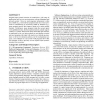151 search results - page 6 / 31 » Using Informal and Formal Techniques for the Reverse Enginee... |
ACISICIS
2007
IEEE
14 years 1 months ago
2007
IEEE
Abstract—An obfuscation aims to transform a program, without affecting its functionality, so that some secret information within the program can be hidden for as long as possible...
APSEC
2004
IEEE
13 years 11 months ago
2004
IEEE
In embedded software development, the programming language C and inline assembly code are traditionally widely used. However, tools for C program-understanding, e.g., cross-refere...
JUCS
2006
13 years 7 months ago
2006
: Program slicing is a well known family of techniques used to identify code fragments which depend on or are depended upon specific program entities. They are particularly useful ...
KBSE
2005
IEEE
14 years 1 months ago
2005
IEEE
Feature location aims at locating pieces of code that implement a given set of features (requirements). It is a necessary first step in every program comprehension and maintenanc...
SIGSOFT
2008
ACM
14 years 8 months ago
2008
ACM
Program input syntactic structure is essential for a wide range of applications such as test case generation, software debugging and network security. However, such important info...

